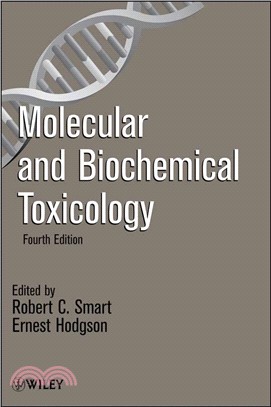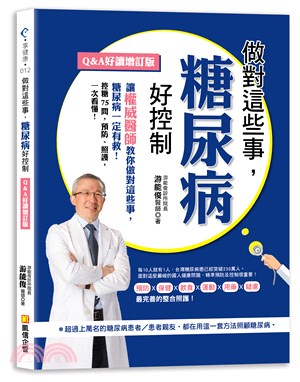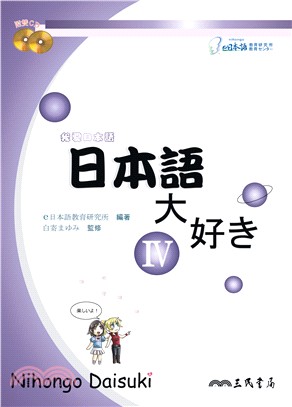Molecular and Biochemical Toxicology
商品資訊
ISBN13:9780470102114
出版社:JOHN WILEY & SONS;LTD
作者:SMART
出版日:2008/07/30
裝訂/頁數:精裝/944頁
版次:4
定價
:NT$ 5128 元優惠價
:90 折 4615 元
若需訂購本書,請電洽客服 02-25006600[分機130、131]。
相關商品
商品簡介
作者簡介
名人/編輯推薦
目次
商品簡介
An essential resource for graduate students, academic and industrial toxicologists, and environmental health scientists and professionals
Over the course of thirty years and three editions, Introduction to Biochemical Toxicology has been an important source for coverage of the ongoing quest to define the biochemical, cellular, and molecular events induced by toxicants at the cellular and organismic levels. Now, as the principles and methods of molecular and cellular biology as well as genomic sciences play an ever increasing role in mechanistic toxicology, significant changes have been made to the book, resulting in this important new edition-now titled Molecular and Biochemical Toxicology, Fourth Edition.
Much more than an introductory text, this crucial new edition has been completely revised to provide timely and thorough coverage of the underlying biochemical, molecular, and cellular mechanisms through which toxicants produce their adverse effects. Toxicological issues are covered from the molecule to the cell to the organ level. Complex methods used in toxicology are also described in a straightforward, easy-to-understand style. Additional features of this new edition include:
New chapters that explore the interface between toxicology and genomic sciences, including: bioinformatics, proteomics, metabolomics, and toxicogenomics
Increased emphasis on structure, mechanism, and regulation of xenobiotic metabolizing enzymes, toxicogenetics, and xenobiotic transporters
Additional new chapters on: molecular epidemiology and genetic susceptibility, DNA damage and mutagenesis, DNA repair, mechanisms of cell death, mitochondrial dysfunction, metals, reproductive toxicology, developmental toxicology, and reactive oxygen/metabolites and toxicity
Molecular and Biochemical Toxicology, Fourth Edition guides graduate students, toxicologists, and environmental health professionals through the principles of molecular and biochemical toxicology and the complex mechanisms of toxicity. Whether it's used in the classroom or in industry, research, or academia, this book is essential for anyone interested in understanding the molecular mechanisms through which toxicants produce adverse effects.
Over the course of thirty years and three editions, Introduction to Biochemical Toxicology has been an important source for coverage of the ongoing quest to define the biochemical, cellular, and molecular events induced by toxicants at the cellular and organismic levels. Now, as the principles and methods of molecular and cellular biology as well as genomic sciences play an ever increasing role in mechanistic toxicology, significant changes have been made to the book, resulting in this important new edition-now titled Molecular and Biochemical Toxicology, Fourth Edition.
Much more than an introductory text, this crucial new edition has been completely revised to provide timely and thorough coverage of the underlying biochemical, molecular, and cellular mechanisms through which toxicants produce their adverse effects. Toxicological issues are covered from the molecule to the cell to the organ level. Complex methods used in toxicology are also described in a straightforward, easy-to-understand style. Additional features of this new edition include:
New chapters that explore the interface between toxicology and genomic sciences, including: bioinformatics, proteomics, metabolomics, and toxicogenomics
Increased emphasis on structure, mechanism, and regulation of xenobiotic metabolizing enzymes, toxicogenetics, and xenobiotic transporters
Additional new chapters on: molecular epidemiology and genetic susceptibility, DNA damage and mutagenesis, DNA repair, mechanisms of cell death, mitochondrial dysfunction, metals, reproductive toxicology, developmental toxicology, and reactive oxygen/metabolites and toxicity
Molecular and Biochemical Toxicology, Fourth Edition guides graduate students, toxicologists, and environmental health professionals through the principles of molecular and biochemical toxicology and the complex mechanisms of toxicity. Whether it's used in the classroom or in industry, research, or academia, this book is essential for anyone interested in understanding the molecular mechanisms through which toxicants produce adverse effects.
作者簡介
Robert C. Smart, PhD, is a Professor in the Department of Environmental and Molecular Toxicology at North Carolina State University. Together with Dr. Hodgson, he coedited the previous edition of this book.
Ernest Hodgson, PhD, is the William Neal Reynolds Professor of Toxicology at North Carolina State University. He edited A Textbook of Modern Toxicology, Third Edition (Wiley) and is the Editor of the Journal of Biochemical and Molecular Toxicology.
Ernest Hodgson, PhD, is the William Neal Reynolds Professor of Toxicology at North Carolina State University. He edited A Textbook of Modern Toxicology, Third Edition (Wiley) and is the Editor of the Journal of Biochemical and Molecular Toxicology.
名人/編輯推薦
"A good introductory textbook covering the biochemical toxicology of organic substances and the relevant methodology in some detail.... It offers good value for money and can be recommended as a textbook for appropriate courses." (BTS Newsletter, Summer 2009)
目次
Preface.
Contributors.
1. Molecular and Biochemical Toxicology: Definition and Scope (Ernest Hodgson and Robert C. Smart).
1.1 Introduction.
1.2 Toxicology.
1.3 Biochemical Toxicology.
1.4 Cellular Toxicology.
1.5 Molecular Toxicology.
1.6 Proteomics, Metabolomics.
1.7 Conclusions.
Suggested Reading.
2. Overview of Molecular Techniques in Toxicology: Genes and Transgenes (Robert C. Smart).
2.1 Applicability of Molecular Techniques to Toxicology.
2.2 Overview of the Genetic Code and Flow of Genetic Information.
2.3 Molecular Cloning.
2.4 Southern and Northern Blot Analyses.
2.5 Polymerase Chain Reaction (PCR).
2.6 Some Methods to Evaluate Gene Expression and Regulation.
2.7 Methods to Evaluate Gene Function.
3. Toxicogenomics (Marjorie F. Oleksiak).
3.1 Introduction.
3.2 A Primer of Genomics.
3.3 Tools and Approaches.
3.4 Genomes.
3.5 Functional Genomics.
3.6 Conclusions.
4. Proteomics (B. Alex Merrick).
4.1 Introduction to Proteomics.
4.2 Properties of Proteins.
4.3 Fields of Proteomic Research.
4.4 Mass Spectrometers and Protein Identification.
4.5 Proteomic Platforms.
4.6 Proteomes and Subproteomes: Expectations and Reality.
4.7 Summary.
5. Metabolomics (Nigel Deighton).
5.1 Introduction.
5.2 Methods.
5.3 Diagnostics and Functional Genomics.
5.4 Metabolomics and Toxicology.
6. Bioinformatics (Eric A. Stone and Dahlia M. Nielsen).
6.1 Introduction.
6.2 Obtaining the Genbank Record of a Known Gene.
6.3 Sequence Comparison.
6.4 Database Searching With BLAST.
6.5 Extensions to Multiple Sequences.
6.6 Genetic Mapping.
6.7 Conclusion.
7 Immunochemical Techniques in Toxicology (Gerald A. LeBlanc).
7.1 Introduction.
7.2 Definitions.
7.3 Immunogens and Antigens.
7.4 Polyclonal Antibodies.
7.5 Monoclonal Antibodies.
7.6 Immunoassays.
7.7 Conclusions.
8. Cellular Techniques (Sharon A. Meyer).
8.1 Introduction.
8.2 Cellular Studies in Intact Tissue.
8.3 Studies with Dispersed, Isolated Cells.
8.4 Monolayer Cell Culture.
8.5 Observation of Cultured Cells.
8.6 Indicators of Toxicity.
8.7 Artifacts and Confounders.
8.8 Replacement of Animal Testing with Cell Culture Models.
8.9 Conclusions.
9. Structure, Mechanism and Regulation of Cytochromes P450 (Darryl C. Zeldin and John M. Seubert).
9.1 Introduction.
9.2 Complexity of the Cytochrome P450 Gene Superfamily.
9.3 Cytochrome P450 Structure.
9.4 Mechanisms of P450 Catalysis.
9.5 Cytochrome P450 Regulation.
9.6 Transgenic Animal Models.
9.7 Reactive Oxygen Species.
9.8 Posttranslation Modification of P450s.
9.9 Summary.
10. Phase I Metabolism of Toxicants and Metabolic Interactions (Ernest Hodgson, Parikshit C. Das, Taehyeon M. Cho and Randy L. Rose).
10.1 Introduction.
10.2 Microsomal Monooxygenations: General Background.
10.3 Nonmicrosomal Oxidations.
10.4 Cooxidation by Prostaglandin Synthetase.
10.5 Reduction Reactions.
10.6 Hydrolysis.
10.7 Epoxide Hydration.
10.8 DDT Dehydrochlorinase.
10.9 Interactions Involving Xenobiotic-Metabolizing Enzymes.
11. Phase I-Pharmacogenetics (Ernest Hodgson and Edward L. Croom).
11.1 Introduction.
11.2 Polymorphisms in CYP Isoforms.
11.3 Polymorphisms in Alcohol Dehydrogenase.
11.4 Polymorphisms in Aldehyde Dehydrogenase.
11.5 Polymorphisms in Flavin-Containing Monooxygenases.
11.6 Polymorphisms in Epoxide Hydrolase.
11.7 Polymorphisms in Serum Cholinesterase.
11.8 Polymorphisms in Paraoxonase (PON1).
11.9 Polymorphisms: Mechanistic Classification.
11.10 Polymorphisms and Drug Metabolism.
11.11 Methods Used For the Study of Polymorphisms.
11.12 Epidemiology.
12. Phase II-Conjugation of Toxicants (Gerald A. LeBlanc).
12.1 Introduction.
12.2 Conjugation Reactions.
12.3 Glycosides.
12.4 Sulfation.
12.5 Methylation.
12.6 Acylation.
12.7 Glutathione S-Transferases.
12.8 Cysteine S-Conjugate ß-Lyase.
12.9 Lipophilic Conjugation.
12.10 Phase II Activation.
12.11 Phase III Elimination.
12.12 Conclusions.
13. Regulation and Polymorphisms in Phase II Genes (Yoshiaki Tsuji).
13.1 Introduction.
13.2 Roles of Phase II Genes and Polymorphisms.
13.3 The Antioxidant Responsive Element and Phase II Gene Regulation.
13.4 Summary.
14. Developmental Effects on Xenobiotic Metabolism (Martin J. J. Ronis and Helen C. Cunny).
14.1 Introduction.
14.2 Xenobiotic Metabolism During Development.
14.3 Effects of Pregnancy on Maternal Xenobiotic Metabolism.
14.4 Developmental Effects on Xenobiotic Metabolism in Non-Mammalian Species.
14.5 Cycles in Development.
15. Cellular Transport and Elimination (David S. Miller).
15.1 Transport as a Determinant of Xenobiotic Action.
15.2 Factors Affecting Membrane/Tissue Permeability.
15.3 Xenobiotic Transporters.
15.4 Altered Xenobiotic Transport.
16. Mechanisms of Cell Death (Mac Law and Susan Elmore).
16.1 Introduction.
16.2 How Cells/Tissues React to "Stress".
16.3 Cell Injury and Cell Death.
16.4 Morphology of Cell Injury and Cell Death.
16.5 Apoptosis.
17. Mitochondrial Dysfunction (Jun Ninomiya-Tsuji).
17.1 Introduction.
17.2 Mitochondrial Function.
17.3 Mitochondrial Apoptosis/Necrosis.
17.4 Toxicant-Induced Mitochondrial Apoptosis/Necrosis.
18. Glutathione-Dependent Mechanisms in Chemically Induced Cell Injury and Cellular Protection Mechanisms (Donald J. Reed).
18.1 Introduction.
18.2 Glutathione-Dependent Conjugation of Chemicals.
18.3 GSH Dependent Bioactivation of Chemicals.
18.4 Oxidative Stress.
18.5 Glutathione Dependent Cellular Defense Systems.
18.6 Glutathione/Glutathionylation Dependent Signaling Systems and Antioxidant Defense.
18.7 Conclusions.
19. Toxicant-Receptor Interactions: Fundamental Principles (Richard B. Mailman).
19.1 Definition of a "Receptor".
19.2 Receptor Superfamilies.
19.3 The Study of Receptor-Toxicant Interactions.
19.4 Relationship of Receptor Occupancy to Functional Effects.
20. Reactive Oxygen/ Reactive Metabolites and Toxicity (Elizabeth L. MacKenzie).
20.1 Introduction.
20.2 Enzymes Involved in Bioactivation.
20.3 Stability of Reactive Metabolites.
20.4 Factors Affecting Activation and Toxicity.
20.5 Reactive Oxygen Species and Toxicity.
21. Metals (David B. Buchwalter).
21.1 Introduction.
21.2 Understanding Metal Ion Reactions in Biological Systems.
21.3 Modes of Metal Toxicity.
21.4 Metals and Oxidative Stress.
21.5 Metallothioneins.
21.6 Examples of Toxic Metals.
21.7 Metals and Cancer.
22. DNA Damage and Mutagenesis (Zhigang Wang).
22.1 Introduction.
22.2 Endogenous DNA Damage.
22.3 Environmental DNA Damage.
22.4 Concepts of Mutagenesis.
22.5 Mechanisms of DNA Damage-Induced Mutagenesis.
23. DNA Repair (Isabel Mellon).
23.1 Introduction.
23.2 Direct Reversal of Base Damage.
23.3 Base Excision Repair.
23.4 Nucleotide Excision Repair.
23.5 Mismatch Repair.
23.6 Recombinational Repair.
23.7 DNA Repair and Chromatin Structure.
23.8 DNA Damage and Cell Cycle Checkpoints.
23.9 Summary.
24. Carcinogenesis (Robert C. Smart, Sarah J. Ewing and Kari D. Loomis).
24.1 Introduction and Historical Perspective.
24.2 Human Cancer.
24.3 Categorization of Agents Associated with Carcinogenesis.
24.4 Somatic Mutation Theory.
24.5 Epigenetic Mechanism of Tumorigenesis.
24.6 Multistage Tumorigenesis.
24.7 Tumor Viruses.
24.8 Cellular Oncogenes.
24.9 Tumor Suppressor Genes.
24.10 Mutator Phenotype/DNA Stability Genes.
24.11 Interactions of Oncogenes and Tumor Suppressor Genes.
24.12 Genetically Modified Mouse Models.
24.13 Conclusions.
25. Genetic Toxicology (R. Julian Preston).
25.1 Introduction and Historical Perspective.
25.2 Genetic Toxicology and Risk Assessment (General Considerations).
25.3 Genotoxicity Assays.
25.4 Use of Mechanistic Data in Cancer and Genetic Risk Assessments (Specific Considerations).
25.5 New Research Directions.
25.6 Conclusions.
26. Molecular Epidemiology and Genetic Susceptibility (Ruth M. Lunn and Marianna Stern).
26.1 Introduction.
26.2 Basic Concepts in Epidemiology.
26.3 Biomarkers Used in Molecular Epidemiology.
26.4 Biomarkers of Genetic Susceptibility.
26.5 Summary and Concluding Remarks.
27. Respiratory Toxicology (James C. Bonner).
27.1 Introduction.
27.2 Anatomy and Function of the Respiratory Tract.
27.3 Toxicant-Induced Lung Injury, Remodeling and Repair.
27.4 Occupational and Environmental Lung Diseases.
28. Hepatotoxicity (Andrew D. Wallace and Sharon A. Meyer).
28.1 Introduction.
28.2 Liver Organization and Cellular Components.
28.3 Types of Chemically Induced Lesions.
28.4 Mechanisms of Chemically Induced Hepatotoxicity.
28.5 Interactions.
28.6 Detection and Prediction of Hepatotoxicity.
28.7 Compounds Causing Liver Injury.
28.8 Conclusion.
29. Biochemical Mechanisms of Renal Toxicity (Joan B. Tarloff and Andrew D. Wallace).
29.1 Introduction.
29.2 Fundamental Aspects of Renal Physiology.
29.3 Factors Contributing to Nephrotoxicity.
29.4 Assessment of Nephrotoxicity.
29.5 Site-Specific Nephrotoxicity.
29.6 Summary.
30. Biochemical Toxicology of the Peripheral Nervous System (Jeffry F. Goodrum, Arrel D. Toews and Thomas W. Bouldin).
30.1 Introduction.
30.2 Specialized Aspects of Neuronal Metabolism.
30.3 Specialized Aspects of Schwann Cell Transport.
30.4 Toxic Neuropathies.
30.5 Conclusion.
31. Biochemical Toxicology of the Central Nervous System (Bonita L. Blake).
31.1 Introduction.
31.2 CNS Sites of Toxic Action.
31.3 Factors Affecting Neurotoxicant Susceptibility.
31.4 Mechanisms of Neurotoxicity and Neuroprotection.
31.5 The Dynamic Nervous System: Adaptibility, Plasticity and Repair.
32. Immunotoxicology (MaryJane K. Selgrade, Dori R. Germolec, Robert W. Luebke, Ralph J. Smialowicz, Marsha D. Ward and Christal C. Bowman).
32.1 Introduction.
32.2 Organization of the Immune System.
32.3 Immunotoxicology.
32.4 Mechanisms of Immune Suppression.
32.5 Mechanisms Associated with Hypersensitivity.
32.6 Mechanisms Associated with Autoimmune Disease.
33. Reproductive Toxicology (John F. Couse).
33.1 Introduction.
33.2 General Principles of Reproductive Toxicology.
33.3 Sexual Differentiation.
33.4 Neuroendocrine Regulation of Reproduction.
33.5 Male Reproductive System.
33.6 Female Reproductive System.
33.7 General Categories of Reproductive Toxicants.
33.8 Summary.
34. Developmental Toxicology (John F. Couse).
34.1 Introduction.
34.2 Overview of Development.
34.3 Wilson’s Principles of Teratology.
34.4 Selected Examples of Developmental Toxicants.
34.5 Summary.
35. Dermatotoxicology (Nancy A. Monteiro-Riviere).
35.1 Introduction.
35.2 Functions of Skin.
35.3 Epidermis.
35.4 Anatomical Factors to Consider in Model Selection.
35.5 Percutaneous Absorption and Penetration.
35.6 Dermatotoxicity.
35.7 Dermal Toxicity of Nanoparticles.
35.8 Conclusion.
Index.
Contributors.
1. Molecular and Biochemical Toxicology: Definition and Scope (Ernest Hodgson and Robert C. Smart).
1.1 Introduction.
1.2 Toxicology.
1.3 Biochemical Toxicology.
1.4 Cellular Toxicology.
1.5 Molecular Toxicology.
1.6 Proteomics, Metabolomics.
1.7 Conclusions.
Suggested Reading.
2. Overview of Molecular Techniques in Toxicology: Genes and Transgenes (Robert C. Smart).
2.1 Applicability of Molecular Techniques to Toxicology.
2.2 Overview of the Genetic Code and Flow of Genetic Information.
2.3 Molecular Cloning.
2.4 Southern and Northern Blot Analyses.
2.5 Polymerase Chain Reaction (PCR).
2.6 Some Methods to Evaluate Gene Expression and Regulation.
2.7 Methods to Evaluate Gene Function.
3. Toxicogenomics (Marjorie F. Oleksiak).
3.1 Introduction.
3.2 A Primer of Genomics.
3.3 Tools and Approaches.
3.4 Genomes.
3.5 Functional Genomics.
3.6 Conclusions.
4. Proteomics (B. Alex Merrick).
4.1 Introduction to Proteomics.
4.2 Properties of Proteins.
4.3 Fields of Proteomic Research.
4.4 Mass Spectrometers and Protein Identification.
4.5 Proteomic Platforms.
4.6 Proteomes and Subproteomes: Expectations and Reality.
4.7 Summary.
5. Metabolomics (Nigel Deighton).
5.1 Introduction.
5.2 Methods.
5.3 Diagnostics and Functional Genomics.
5.4 Metabolomics and Toxicology.
6. Bioinformatics (Eric A. Stone and Dahlia M. Nielsen).
6.1 Introduction.
6.2 Obtaining the Genbank Record of a Known Gene.
6.3 Sequence Comparison.
6.4 Database Searching With BLAST.
6.5 Extensions to Multiple Sequences.
6.6 Genetic Mapping.
6.7 Conclusion.
7 Immunochemical Techniques in Toxicology (Gerald A. LeBlanc).
7.1 Introduction.
7.2 Definitions.
7.3 Immunogens and Antigens.
7.4 Polyclonal Antibodies.
7.5 Monoclonal Antibodies.
7.6 Immunoassays.
7.7 Conclusions.
8. Cellular Techniques (Sharon A. Meyer).
8.1 Introduction.
8.2 Cellular Studies in Intact Tissue.
8.3 Studies with Dispersed, Isolated Cells.
8.4 Monolayer Cell Culture.
8.5 Observation of Cultured Cells.
8.6 Indicators of Toxicity.
8.7 Artifacts and Confounders.
8.8 Replacement of Animal Testing with Cell Culture Models.
8.9 Conclusions.
9. Structure, Mechanism and Regulation of Cytochromes P450 (Darryl C. Zeldin and John M. Seubert).
9.1 Introduction.
9.2 Complexity of the Cytochrome P450 Gene Superfamily.
9.3 Cytochrome P450 Structure.
9.4 Mechanisms of P450 Catalysis.
9.5 Cytochrome P450 Regulation.
9.6 Transgenic Animal Models.
9.7 Reactive Oxygen Species.
9.8 Posttranslation Modification of P450s.
9.9 Summary.
10. Phase I Metabolism of Toxicants and Metabolic Interactions (Ernest Hodgson, Parikshit C. Das, Taehyeon M. Cho and Randy L. Rose).
10.1 Introduction.
10.2 Microsomal Monooxygenations: General Background.
10.3 Nonmicrosomal Oxidations.
10.4 Cooxidation by Prostaglandin Synthetase.
10.5 Reduction Reactions.
10.6 Hydrolysis.
10.7 Epoxide Hydration.
10.8 DDT Dehydrochlorinase.
10.9 Interactions Involving Xenobiotic-Metabolizing Enzymes.
11. Phase I-Pharmacogenetics (Ernest Hodgson and Edward L. Croom).
11.1 Introduction.
11.2 Polymorphisms in CYP Isoforms.
11.3 Polymorphisms in Alcohol Dehydrogenase.
11.4 Polymorphisms in Aldehyde Dehydrogenase.
11.5 Polymorphisms in Flavin-Containing Monooxygenases.
11.6 Polymorphisms in Epoxide Hydrolase.
11.7 Polymorphisms in Serum Cholinesterase.
11.8 Polymorphisms in Paraoxonase (PON1).
11.9 Polymorphisms: Mechanistic Classification.
11.10 Polymorphisms and Drug Metabolism.
11.11 Methods Used For the Study of Polymorphisms.
11.12 Epidemiology.
12. Phase II-Conjugation of Toxicants (Gerald A. LeBlanc).
12.1 Introduction.
12.2 Conjugation Reactions.
12.3 Glycosides.
12.4 Sulfation.
12.5 Methylation.
12.6 Acylation.
12.7 Glutathione S-Transferases.
12.8 Cysteine S-Conjugate ß-Lyase.
12.9 Lipophilic Conjugation.
12.10 Phase II Activation.
12.11 Phase III Elimination.
12.12 Conclusions.
13. Regulation and Polymorphisms in Phase II Genes (Yoshiaki Tsuji).
13.1 Introduction.
13.2 Roles of Phase II Genes and Polymorphisms.
13.3 The Antioxidant Responsive Element and Phase II Gene Regulation.
13.4 Summary.
14. Developmental Effects on Xenobiotic Metabolism (Martin J. J. Ronis and Helen C. Cunny).
14.1 Introduction.
14.2 Xenobiotic Metabolism During Development.
14.3 Effects of Pregnancy on Maternal Xenobiotic Metabolism.
14.4 Developmental Effects on Xenobiotic Metabolism in Non-Mammalian Species.
14.5 Cycles in Development.
15. Cellular Transport and Elimination (David S. Miller).
15.1 Transport as a Determinant of Xenobiotic Action.
15.2 Factors Affecting Membrane/Tissue Permeability.
15.3 Xenobiotic Transporters.
15.4 Altered Xenobiotic Transport.
16. Mechanisms of Cell Death (Mac Law and Susan Elmore).
16.1 Introduction.
16.2 How Cells/Tissues React to "Stress".
16.3 Cell Injury and Cell Death.
16.4 Morphology of Cell Injury and Cell Death.
16.5 Apoptosis.
17. Mitochondrial Dysfunction (Jun Ninomiya-Tsuji).
17.1 Introduction.
17.2 Mitochondrial Function.
17.3 Mitochondrial Apoptosis/Necrosis.
17.4 Toxicant-Induced Mitochondrial Apoptosis/Necrosis.
18. Glutathione-Dependent Mechanisms in Chemically Induced Cell Injury and Cellular Protection Mechanisms (Donald J. Reed).
18.1 Introduction.
18.2 Glutathione-Dependent Conjugation of Chemicals.
18.3 GSH Dependent Bioactivation of Chemicals.
18.4 Oxidative Stress.
18.5 Glutathione Dependent Cellular Defense Systems.
18.6 Glutathione/Glutathionylation Dependent Signaling Systems and Antioxidant Defense.
18.7 Conclusions.
19. Toxicant-Receptor Interactions: Fundamental Principles (Richard B. Mailman).
19.1 Definition of a "Receptor".
19.2 Receptor Superfamilies.
19.3 The Study of Receptor-Toxicant Interactions.
19.4 Relationship of Receptor Occupancy to Functional Effects.
20. Reactive Oxygen/ Reactive Metabolites and Toxicity (Elizabeth L. MacKenzie).
20.1 Introduction.
20.2 Enzymes Involved in Bioactivation.
20.3 Stability of Reactive Metabolites.
20.4 Factors Affecting Activation and Toxicity.
20.5 Reactive Oxygen Species and Toxicity.
21. Metals (David B. Buchwalter).
21.1 Introduction.
21.2 Understanding Metal Ion Reactions in Biological Systems.
21.3 Modes of Metal Toxicity.
21.4 Metals and Oxidative Stress.
21.5 Metallothioneins.
21.6 Examples of Toxic Metals.
21.7 Metals and Cancer.
22. DNA Damage and Mutagenesis (Zhigang Wang).
22.1 Introduction.
22.2 Endogenous DNA Damage.
22.3 Environmental DNA Damage.
22.4 Concepts of Mutagenesis.
22.5 Mechanisms of DNA Damage-Induced Mutagenesis.
23. DNA Repair (Isabel Mellon).
23.1 Introduction.
23.2 Direct Reversal of Base Damage.
23.3 Base Excision Repair.
23.4 Nucleotide Excision Repair.
23.5 Mismatch Repair.
23.6 Recombinational Repair.
23.7 DNA Repair and Chromatin Structure.
23.8 DNA Damage and Cell Cycle Checkpoints.
23.9 Summary.
24. Carcinogenesis (Robert C. Smart, Sarah J. Ewing and Kari D. Loomis).
24.1 Introduction and Historical Perspective.
24.2 Human Cancer.
24.3 Categorization of Agents Associated with Carcinogenesis.
24.4 Somatic Mutation Theory.
24.5 Epigenetic Mechanism of Tumorigenesis.
24.6 Multistage Tumorigenesis.
24.7 Tumor Viruses.
24.8 Cellular Oncogenes.
24.9 Tumor Suppressor Genes.
24.10 Mutator Phenotype/DNA Stability Genes.
24.11 Interactions of Oncogenes and Tumor Suppressor Genes.
24.12 Genetically Modified Mouse Models.
24.13 Conclusions.
25. Genetic Toxicology (R. Julian Preston).
25.1 Introduction and Historical Perspective.
25.2 Genetic Toxicology and Risk Assessment (General Considerations).
25.3 Genotoxicity Assays.
25.4 Use of Mechanistic Data in Cancer and Genetic Risk Assessments (Specific Considerations).
25.5 New Research Directions.
25.6 Conclusions.
26. Molecular Epidemiology and Genetic Susceptibility (Ruth M. Lunn and Marianna Stern).
26.1 Introduction.
26.2 Basic Concepts in Epidemiology.
26.3 Biomarkers Used in Molecular Epidemiology.
26.4 Biomarkers of Genetic Susceptibility.
26.5 Summary and Concluding Remarks.
27. Respiratory Toxicology (James C. Bonner).
27.1 Introduction.
27.2 Anatomy and Function of the Respiratory Tract.
27.3 Toxicant-Induced Lung Injury, Remodeling and Repair.
27.4 Occupational and Environmental Lung Diseases.
28. Hepatotoxicity (Andrew D. Wallace and Sharon A. Meyer).
28.1 Introduction.
28.2 Liver Organization and Cellular Components.
28.3 Types of Chemically Induced Lesions.
28.4 Mechanisms of Chemically Induced Hepatotoxicity.
28.5 Interactions.
28.6 Detection and Prediction of Hepatotoxicity.
28.7 Compounds Causing Liver Injury.
28.8 Conclusion.
29. Biochemical Mechanisms of Renal Toxicity (Joan B. Tarloff and Andrew D. Wallace).
29.1 Introduction.
29.2 Fundamental Aspects of Renal Physiology.
29.3 Factors Contributing to Nephrotoxicity.
29.4 Assessment of Nephrotoxicity.
29.5 Site-Specific Nephrotoxicity.
29.6 Summary.
30. Biochemical Toxicology of the Peripheral Nervous System (Jeffry F. Goodrum, Arrel D. Toews and Thomas W. Bouldin).
30.1 Introduction.
30.2 Specialized Aspects of Neuronal Metabolism.
30.3 Specialized Aspects of Schwann Cell Transport.
30.4 Toxic Neuropathies.
30.5 Conclusion.
31. Biochemical Toxicology of the Central Nervous System (Bonita L. Blake).
31.1 Introduction.
31.2 CNS Sites of Toxic Action.
31.3 Factors Affecting Neurotoxicant Susceptibility.
31.4 Mechanisms of Neurotoxicity and Neuroprotection.
31.5 The Dynamic Nervous System: Adaptibility, Plasticity and Repair.
32. Immunotoxicology (MaryJane K. Selgrade, Dori R. Germolec, Robert W. Luebke, Ralph J. Smialowicz, Marsha D. Ward and Christal C. Bowman).
32.1 Introduction.
32.2 Organization of the Immune System.
32.3 Immunotoxicology.
32.4 Mechanisms of Immune Suppression.
32.5 Mechanisms Associated with Hypersensitivity.
32.6 Mechanisms Associated with Autoimmune Disease.
33. Reproductive Toxicology (John F. Couse).
33.1 Introduction.
33.2 General Principles of Reproductive Toxicology.
33.3 Sexual Differentiation.
33.4 Neuroendocrine Regulation of Reproduction.
33.5 Male Reproductive System.
33.6 Female Reproductive System.
33.7 General Categories of Reproductive Toxicants.
33.8 Summary.
34. Developmental Toxicology (John F. Couse).
34.1 Introduction.
34.2 Overview of Development.
34.3 Wilson’s Principles of Teratology.
34.4 Selected Examples of Developmental Toxicants.
34.5 Summary.
35. Dermatotoxicology (Nancy A. Monteiro-Riviere).
35.1 Introduction.
35.2 Functions of Skin.
35.3 Epidermis.
35.4 Anatomical Factors to Consider in Model Selection.
35.5 Percutaneous Absorption and Penetration.
35.6 Dermatotoxicity.
35.7 Dermal Toxicity of Nanoparticles.
35.8 Conclusion.
Index.
主題書展
更多
主題書展
更多書展本週66折
您曾經瀏覽過的商品
購物須知
外文書商品之書封,為出版社提供之樣本。實際出貨商品,以出版社所提供之現有版本為主。部份書籍,因出版社供應狀況特殊,匯率將依實際狀況做調整。
無庫存之商品,在您完成訂單程序之後,將以空運的方式為你下單調貨。為了縮短等待的時間,建議您將外文書與其他商品分開下單,以獲得最快的取貨速度,平均調貨時間為1~2個月。
為了保護您的權益,「三民網路書店」提供會員七日商品鑑賞期(收到商品為起始日)。
若要辦理退貨,請在商品鑑賞期內寄回,且商品必須是全新狀態與完整包裝(商品、附件、發票、隨貨贈品等)否則恕不接受退貨。






















